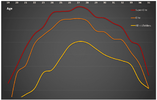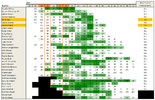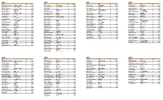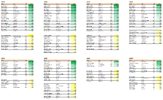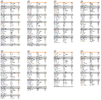Midfielders. The core of all successful teams. Building one is not a straightforward process however and can be expected to take a significant period relying upon the luck of the draft and the selections available.
But could the process be fast-tracked through the recruitment of players who are ready to make a midfield contribution – and could such players be identified early through the use of data?
What are we looking for?
What makes a good midfielder in a way that can be easily measured? If we keep things very simple, they can be defined in terms of four outputs: Disposals, Contested Possessions, Clearances and Inside 50s. As we would have it, there already exists such a data set covering every season from 2005 onwards (it can be read about specifically here).
Note: Statistics in this data set have been modified to remove instances where “unused substitutes” are included as matches – for example T.Bedford of Melbourne is listed as playing 17 matches thus far in 2022, yet didn’t make it onto the ground at all for 7 of those. Surprisingly, it is almost impossible to find a resource that reasonably compiles unused substitutes, considering how much it can skew average data for individual players – I ended up doing it myself manually and will probably publish it later onto an existing resource for others to make use of.
If we take the last ten years of this data, 80 players can be found to have placed inside the top 20 overall at the end of a season. These shall be referred to as “elite”.
If we shift this out further to those players who have placed inside the top 20 overall on four or more occasions, the number reduces to just 33 – this benchmark henceforth shall be referred to as “super-elite”.
So, using this information, can we define reliable precursors to elite midfield performance that can be used to forecast future targets? Let’s take a look.
Early Achievers
What stands out about the development of top-level midfielders?
Here is a chart of three midfield groupings [All midfielders, Elite and Super-Elite] by age vs average rating:
If we filter for this accelerated development by the following means:
We return an output that includes all but two (93.1%) of Super-Elite midfielders over the past decade.
Four Eagles make the list: Yeo, Shuey, Priddis and Judd. S.Mitchell's super-elite days were behind him before he came to the club.
Could this be used as a forecasting tool, however?
The data suggests this is plausible, with instances of such accelerated development leading to later elite and super-elite outcomes at rates many times above average.
If we look since 2015, players who satisfied these criteria who were no older than 24 at season close are as follows:
A list full of stars for sure. However, we may have identified players on the fast-track to improvement, but it could also be argued that we haven’t really identified much here in addition to what we already knew - the overwhelming majority being recent first round draft picks that would never be traded, or have far too prohibitive a cost associated if they were to be.
Time to find an alternative method.
Getting Artificial
As part of my everyday job I train AIs to process massive amounts of data into outputs that are useful. Could an AI provide a better outcome for identifying midfield talent?
I spun up a test environment, uploaded the dataset, gave a few basic parameters [identify and then forecast improvement] and awaited the results.
Initially it just spat out a list of names without any context. After refining the parameters further to quantify the forecast and letting it “learn” for a period, effectively building its own datasets at a massive scale based on the one given and testing itself over and over, using the original as a control, we got this:
Two sets of figures, one positive and the other negative.
Positive figures align with stoppage midfielders, higher values indicate greater potential. Above +4 gives a greater than 80% probability over the past 15 years of becoming an elite top 20 midfielder. Figures above +8 all but guarantee development of super-elite talent.
Negative figures are somewhat more nebulous – perhaps the best fit to describe it would be ‘stoppage-to-stoppage capacity’, lower values indicate greater potential. Figures below -1 appear to signal ability to transition to a more stoppage-focused role. Below -4 all but guarantees development of super-elite talent.
If we also look at these outputs since 2015, we find the following players:
Note W.Brodie with successive 4+ seasons in 2018-19.
Interesting. Certainly useful, but it is identifying the low-hanging fruit as it were. We want to find the hidden gems, players that have been overlooked and forced into taking the non-conventional route in their development. Players that are relatively cheap to procure, yet when provided with the right opportunity, can have a serious positive impact in the midfield.
In other words, the next Elliot Yeo
.
Finding the next Yeo
As we saw earlier, Yeo is one of only two super-elite players of the past decade to not display accelerated development during his early years (the other being L.Neale). Unlike Neale (who was identified by the previous AI model at the age of 21 with +5 potential rating), Yeo remained largely hidden due to his positioning away from the midfield.
The retirements of Priddis and Mitchell provided him with the opportunity for greater midfield time in 2018 and we all know what happened next…
So, if we take the data of Yeo in 2017 and give it to the AI as a template to build a model around, will it identify similar players waiting for an opportunity?
Let’s take a look – again from 2015:
Yellow indicates potential for rapid development if given greater midfield opportunity; Orange indicates similar potential, but output is likely to be limited due to the player's smaller physical size.
Note G.Hewett being identified in 2021 ahead of his move to Carlton.
It certainly appears to be on the right track.
But could we take this further? What if we were to take the data of Yeo as a 21 year old in 2014, during his first season as an Eagle and of other players prior to their initial breakout seasons – would it indicate later midfield greatness and could it be then used to forecast the next generation of stars under development?
Building such a model, with its output capped at a maximum age of 23 provides the following results over the period:
Note that no West Coast players are listed here since Sheed in 2017.
These are sizeable lists. However, we do appear to be getting a much better handle upon identifying talent that is not necessarily taking the direct route in development due to lessened opportunity but retains the potential to mature rapidly once it is given.
Again, repeated instances are indicative of greater potential. For the period 2012-2018, just two instances results in a greater probability than 1 in 4 that the player will have at least one top 20 season in coming years. Three such instances shifts that probability to almost 2 in 3 – in other words far more likely than not.
Putting it Together
So, what options do we have in front of us? As much as we would like to have M.Rowell and C.Oliver, that isn’t going to happen, so what are some of the other opportunities out there to improve our fortunes in the midfield that are potentially workable?
If we take our identified shortlist of talent and add home state and contractual status to it, we find several candidates as possible targets:
Deven Robertson (Brisbane Lions)
185cm, 83kg, 30/6/2001 (21 years old)
State: WA, Contract: 2023
In our final list of midfield potential that we generated, in 2022 there are just two players from WA: C.Warner and D.Robertson. 2022 also happened to be his second successive appearance on this list, which is impressive for a player that has only been granted 21 matches in 3 years.
Massive midfield talent. The no.22 pick from 2019 is currently hindered by the deep pecking order for the Lion’s midfield and that he is purely a midfielder – playing him on the forward or half back flanks simply does not work.
Go read the Lions’ board and you’ll quickly find that the majority there want Robertson in now to replace J.Lyons. Plays like T.Cotchin. Contracted until 2023 but now is the time to go after him before Brisbane embed him into the next generation of midfield they are building and whilst Fremantle are tied down with securing L.Jackson. Lions need points for their father/son prospects – a pick (with the agreement of not bidding on W.Ashcroft) in exchange for D.Robertson could be good business for both clubs.
Former WA U18 captain, Larke medallist and nephew of D.Glass. Seriously, just get this one done already.
Rhys Mathieson (Brisbane Lions)
186cm, 87kg, 10/1/1997 (25 years old)
State: VIC, Contract: 2023 RFA
People are polarised by Mathieson. I have a confession – I flipping love him. Enjoys the hard stuff, gets under the skin of opponents and flies the flag for his team-mates – he would be fantastic to play with in a team. Granted, he certainly has a ‘unique’ personality, but considering he was on the fast-track to elite development that was aborted by lessened opportunity, he has acted always with a team-first perspective and provided leadership to the reserves team. AI calculated score of +5.55 before the age of 20 underscores the amount of untapped potential within him.
Twin recruitments of L.Neale and J.Lyons (both super-elite midfielders) entering 2019, pushed him to the fringe, playing just 28 matches over the last 4 years
Was there on the Friday evening last month when the Lions reserves were playing nearby and saw him rack up 48 disposals and 17 clearances against the Bullants in the VFL. Just set him up C.Oliver-style at a stoppage and he’ll get to work. Arguably the best player in the competition that is not regularly playing AFL.
Is a ‘pre-agent’, coming up as RFA next year. If the club wants to get him, this year is the time to do so, as Brisbane need to get creative with points for their father/sons and Geelong will no doubt exercise that free agency status in 2023 for a Geelong Falcons product.
Harry Perryman (GWS)
186cm, 84kg, 19/12/1998 (23 years old)
State: NSW, Contract: 2024
The forgotten Giant. An academy pick at no.14 in 2016, Perryman gets outshone by other names that do flashier things, but he is consistent, has brilliant decision-making ability and according to our data, is more than ready to take another step up in the midfield.
Perryman is highlighted in each of the past two years as a midfielder that has potential to develop rapidly if given opportunity. G.Hewett and T.Atkins were flagged similarly and have both exploded this year when given a chance.
If things at GWS are as bad as some of the whispers have suggested in terms of salary cap squeeze, Perryman would be the perfect target for acquiring a player as part of a salary dump.
He may need some convincing however, being a NSW product and committing to a two year contract extension earlier this year.
Tanner Bruhn (GWS)
183cm, 77kg, 27/5/2002 (20 years old)
State: VIC, Contract: 2022
Terrific talent and already showing accelerated development in just his second season. Contract is expiring and is (unofficially) looking to be playing elsewhere in 2023. Regardless of that, the pick 12 from two years ago will drive a hefty price.
Despite acknowledgements that he supports the Eagles, he is a Geelong Falcons product and is widely expected to do what Falcons do and fly back to Geelong.
Tim Taranto (GWS)
188cm, 89kg, 28/1/1998 (24 years old)
State: VIC, Contract: 2022
Another GWS player. Allegedly being squeezed out against his will at the Giants as a result of their problems with the salary cap. Four instances of both accelerated development and AI midfield potential. The no.2 pick from 2016 needs to be on the inside, but is down the pecking order and now has an expiring contract. 17 clubs will be interested – our task is to convince him of relocating west of the Nullarbor and then walk him to the pre-season draft.
Liam Baker (Richmond)
173cm, 72kg, 27/1/1998 (24 years old)
State: WA, Contract:2022 [Edit: 2024]
The 2017 rookie-draft selection does pose as an option – however that is primarily due to his origin and contract. Our data highlights him in 2021 as a player with potential for rapid midfield development if provided with opportunity there, but also signifies that his impact would be limited by his small physical size. As media attention increases, the potential cost to secure him is now arguably greater than the amount of benefit his addition would bring. If we were interested, the time to get him was last year, not this year.
Edit – L.Baker re-signed with Richmond today for a further two seasons.
Sam Powell-Pepper (Port Adelaide)
187cm, 96kg, 8/1/1998 (24 years old)
State: WA, Contract: 2023
If we trade-in SPP will it open a hole in the space-time continuum that brings back Dark Sharks ?
We know enough about him, he’s a campaigner but has talent existing within him that is yet to be tapped. With x3 instances of accelerated development flags and x4 instances in our AI midfield potential lists, the data agrees with this conclusion.
Ticks the boxes for a trade target. More likely to be a feature for discussion in 2023 unless Port do something drastic in trying to sign J.Hopper or B.Grundy and are looking for a means to salary dump.
Willem Drew (Port Adelaide)
188cm, 87kg, 1/10/1998 (23 years old)
State: VIC, Contract: 2024
The definition of flying under the radar. No fuss, gets the job done time and time again and lets his team-mates take the cameras. The no.33 pick from 2016 is one of only two players (alongside T.Green) to feature AI scores of +2 in both of the last two years.
Very much a long shot this one; is a favourite of Hinkley and signed a two year contract extension in March.
Brandan Parfitt (Geelong)
180cm, 79kg, 27/4/1998 (24 years old)
State: NT, Contract 2022
Another of those continually emerging types, that continue to be injured just as they are poised to step up. Two instances of accelerated development in addition to multiple flags of readiness for greater opportunities. Similar to L.Baker, his midfield impact is likely to be limited by his smaller stature. Contract expiring this year, but is very likely to accept Geelong’s current offer of a two year extension.
Paddy Dow (Carlton)
187cm, 83kg, 16/10/1999 (22 years old)
State: VIC, Contract: 2023
It’s somewhat surprising that P.Dow is still only 22, considering how long it seems that Carlton have been pinning their hopes upon the former no.3 pick. Two instances of accelerated development and three of AI midfield potential – yet has only played 20 matches over the last three years.
An unlikely target, but worth the question if the Blues are willing to hear offers for a player currently on their fringe. Seems likely to join up with his brother at Richmond.
James Cousins (Williamstown)
185cm, 84kg, 19/3/1998 (24 years old)
State: VIC, Contract: Nil
What happened to J.Cousins? Developing nicely on the wing at Hawthorn, gets on the wrong side of S.Mitchell for reasons unknown and is delisted in 2021 with no other club picking him up.
Went back to Williamstown in the VFL and is averaging just under 30 disposals per game in a midfield without any support. Listed as a contingency top-up player by GWS (who were allocated rights to Williamstown) this season.
Could be a handy ‘B’ player pickup for the cost of nothing.
So there we have it, a data-driven list of targets to improve the midfield and short-cut the necessary time to complete a rebuild.
Over to you West Coast.
But could the process be fast-tracked through the recruitment of players who are ready to make a midfield contribution – and could such players be identified early through the use of data?
What are we looking for?
What makes a good midfielder in a way that can be easily measured? If we keep things very simple, they can be defined in terms of four outputs: Disposals, Contested Possessions, Clearances and Inside 50s. As we would have it, there already exists such a data set covering every season from 2005 onwards (it can be read about specifically here).
Note: Statistics in this data set have been modified to remove instances where “unused substitutes” are included as matches – for example T.Bedford of Melbourne is listed as playing 17 matches thus far in 2022, yet didn’t make it onto the ground at all for 7 of those. Surprisingly, it is almost impossible to find a resource that reasonably compiles unused substitutes, considering how much it can skew average data for individual players – I ended up doing it myself manually and will probably publish it later onto an existing resource for others to make use of.
If we take the last ten years of this data, 80 players can be found to have placed inside the top 20 overall at the end of a season. These shall be referred to as “elite”.
If we shift this out further to those players who have placed inside the top 20 overall on four or more occasions, the number reduces to just 33 – this benchmark henceforth shall be referred to as “super-elite”.
So, using this information, can we define reliable precursors to elite midfield performance that can be used to forecast future targets? Let’s take a look.
Early Achievers
What stands out about the development of top-level midfielders?
Here is a chart of three midfield groupings [All midfielders, Elite and Super-Elite] by age vs average rating:
It is clearly apparent that the highest achievers develop at an accelerated rate in comparison to their peers.If we filter for this accelerated development by the following means:
- Top 150 before the year the player turns 21
- Top 100 before the year the player turns 22
- Top 50 before the year the player turns 24
- Top 20 before the year the player turns 25
We return an output that includes all but two (93.1%) of Super-Elite midfielders over the past decade.
Four Eagles make the list: Yeo, Shuey, Priddis and Judd. S.Mitchell's super-elite days were behind him before he came to the club.
Could this be used as a forecasting tool, however?
The data suggests this is plausible, with instances of such accelerated development leading to later elite and super-elite outcomes at rates many times above average.
If we look since 2015, players who satisfied these criteria who were no older than 24 at season close are as follows:
A list full of stars for sure. However, we may have identified players on the fast-track to improvement, but it could also be argued that we haven’t really identified much here in addition to what we already knew - the overwhelming majority being recent first round draft picks that would never be traded, or have far too prohibitive a cost associated if they were to be.
Time to find an alternative method.
Getting Artificial
As part of my everyday job I train AIs to process massive amounts of data into outputs that are useful. Could an AI provide a better outcome for identifying midfield talent?
I spun up a test environment, uploaded the dataset, gave a few basic parameters [identify and then forecast improvement] and awaited the results.
Initially it just spat out a list of names without any context. After refining the parameters further to quantify the forecast and letting it “learn” for a period, effectively building its own datasets at a massive scale based on the one given and testing itself over and over, using the original as a control, we got this:
Two sets of figures, one positive and the other negative.
Positive figures align with stoppage midfielders, higher values indicate greater potential. Above +4 gives a greater than 80% probability over the past 15 years of becoming an elite top 20 midfielder. Figures above +8 all but guarantee development of super-elite talent.
Negative figures are somewhat more nebulous – perhaps the best fit to describe it would be ‘stoppage-to-stoppage capacity’, lower values indicate greater potential. Figures below -1 appear to signal ability to transition to a more stoppage-focused role. Below -4 all but guarantees development of super-elite talent.
If we also look at these outputs since 2015, we find the following players:
Note W.Brodie with successive 4+ seasons in 2018-19.
Interesting. Certainly useful, but it is identifying the low-hanging fruit as it were. We want to find the hidden gems, players that have been overlooked and forced into taking the non-conventional route in their development. Players that are relatively cheap to procure, yet when provided with the right opportunity, can have a serious positive impact in the midfield.
In other words, the next Elliot Yeo
PLAYERCARDSTART
6
Elliot Yeo
- Age
- 31
- Ht
- 191cm
- Wt
- 91kg
- Pos.
- Mid
Career
Season
Last 5
- D
- 19.5
- 5star
- K
- 11.7
- 4star
- HB
- 7.8
- 5star
- M
- 4.6
- 4star
- T
- 4.5
- 5star
- CL
- 3.0
- 4star
- D
- 18.9
- 4star
- K
- 10.9
- 4star
- HB
- 8.0
- 4star
- M
- 2.1
- 2star
- T
- 5.8
- 5star
- CL
- 5.5
- 5star
- D
- 16.6
- 4star
- K
- 9.4
- 4star
- HB
- 7.2
- 5star
- M
- 3.6
- 4star
- T
- 0.6
- 3star
- CL
- 1.4
- 4star
PLAYERCARDEND
Finding the next Yeo
As we saw earlier, Yeo is one of only two super-elite players of the past decade to not display accelerated development during his early years (the other being L.Neale). Unlike Neale (who was identified by the previous AI model at the age of 21 with +5 potential rating), Yeo remained largely hidden due to his positioning away from the midfield.
The retirements of Priddis and Mitchell provided him with the opportunity for greater midfield time in 2018 and we all know what happened next…
So, if we take the data of Yeo in 2017 and give it to the AI as a template to build a model around, will it identify similar players waiting for an opportunity?
Let’s take a look – again from 2015:
Yellow indicates potential for rapid development if given greater midfield opportunity; Orange indicates similar potential, but output is likely to be limited due to the player's smaller physical size.
Note G.Hewett being identified in 2021 ahead of his move to Carlton.
It certainly appears to be on the right track.
But could we take this further? What if we were to take the data of Yeo as a 21 year old in 2014, during his first season as an Eagle and of other players prior to their initial breakout seasons – would it indicate later midfield greatness and could it be then used to forecast the next generation of stars under development?
Building such a model, with its output capped at a maximum age of 23 provides the following results over the period:
Note that no West Coast players are listed here since Sheed in 2017.
These are sizeable lists. However, we do appear to be getting a much better handle upon identifying talent that is not necessarily taking the direct route in development due to lessened opportunity but retains the potential to mature rapidly once it is given.
Again, repeated instances are indicative of greater potential. For the period 2012-2018, just two instances results in a greater probability than 1 in 4 that the player will have at least one top 20 season in coming years. Three such instances shifts that probability to almost 2 in 3 – in other words far more likely than not.
Putting it Together
So, what options do we have in front of us? As much as we would like to have M.Rowell and C.Oliver, that isn’t going to happen, so what are some of the other opportunities out there to improve our fortunes in the midfield that are potentially workable?
If we take our identified shortlist of talent and add home state and contractual status to it, we find several candidates as possible targets:
Deven Robertson (Brisbane Lions)
185cm, 83kg, 30/6/2001 (21 years old)
State: WA, Contract: 2023
In our final list of midfield potential that we generated, in 2022 there are just two players from WA: C.Warner and D.Robertson. 2022 also happened to be his second successive appearance on this list, which is impressive for a player that has only been granted 21 matches in 3 years.
Massive midfield talent. The no.22 pick from 2019 is currently hindered by the deep pecking order for the Lion’s midfield and that he is purely a midfielder – playing him on the forward or half back flanks simply does not work.
Go read the Lions’ board and you’ll quickly find that the majority there want Robertson in now to replace J.Lyons. Plays like T.Cotchin. Contracted until 2023 but now is the time to go after him before Brisbane embed him into the next generation of midfield they are building and whilst Fremantle are tied down with securing L.Jackson. Lions need points for their father/son prospects – a pick (with the agreement of not bidding on W.Ashcroft) in exchange for D.Robertson could be good business for both clubs.
Former WA U18 captain, Larke medallist and nephew of D.Glass. Seriously, just get this one done already.
Rhys Mathieson (Brisbane Lions)
186cm, 87kg, 10/1/1997 (25 years old)
State: VIC, Contract: 2023 RFA
People are polarised by Mathieson. I have a confession – I flipping love him. Enjoys the hard stuff, gets under the skin of opponents and flies the flag for his team-mates – he would be fantastic to play with in a team. Granted, he certainly has a ‘unique’ personality, but considering he was on the fast-track to elite development that was aborted by lessened opportunity, he has acted always with a team-first perspective and provided leadership to the reserves team. AI calculated score of +5.55 before the age of 20 underscores the amount of untapped potential within him.
Twin recruitments of L.Neale and J.Lyons (both super-elite midfielders) entering 2019, pushed him to the fringe, playing just 28 matches over the last 4 years
Was there on the Friday evening last month when the Lions reserves were playing nearby and saw him rack up 48 disposals and 17 clearances against the Bullants in the VFL. Just set him up C.Oliver-style at a stoppage and he’ll get to work. Arguably the best player in the competition that is not regularly playing AFL.
Is a ‘pre-agent’, coming up as RFA next year. If the club wants to get him, this year is the time to do so, as Brisbane need to get creative with points for their father/sons and Geelong will no doubt exercise that free agency status in 2023 for a Geelong Falcons product.
Harry Perryman (GWS)
186cm, 84kg, 19/12/1998 (23 years old)
State: NSW, Contract: 2024
The forgotten Giant. An academy pick at no.14 in 2016, Perryman gets outshone by other names that do flashier things, but he is consistent, has brilliant decision-making ability and according to our data, is more than ready to take another step up in the midfield.
Perryman is highlighted in each of the past two years as a midfielder that has potential to develop rapidly if given opportunity. G.Hewett and T.Atkins were flagged similarly and have both exploded this year when given a chance.
If things at GWS are as bad as some of the whispers have suggested in terms of salary cap squeeze, Perryman would be the perfect target for acquiring a player as part of a salary dump.
He may need some convincing however, being a NSW product and committing to a two year contract extension earlier this year.
Tanner Bruhn (GWS)
183cm, 77kg, 27/5/2002 (20 years old)
State: VIC, Contract: 2022
Terrific talent and already showing accelerated development in just his second season. Contract is expiring and is (unofficially) looking to be playing elsewhere in 2023. Regardless of that, the pick 12 from two years ago will drive a hefty price.
Despite acknowledgements that he supports the Eagles, he is a Geelong Falcons product and is widely expected to do what Falcons do and fly back to Geelong.
Tim Taranto (GWS)
188cm, 89kg, 28/1/1998 (24 years old)
State: VIC, Contract: 2022
Another GWS player. Allegedly being squeezed out against his will at the Giants as a result of their problems with the salary cap. Four instances of both accelerated development and AI midfield potential. The no.2 pick from 2016 needs to be on the inside, but is down the pecking order and now has an expiring contract. 17 clubs will be interested – our task is to convince him of relocating west of the Nullarbor and then walk him to the pre-season draft.
Liam Baker (Richmond)
173cm, 72kg, 27/1/1998 (24 years old)
State: WA, Contract:
The 2017 rookie-draft selection does pose as an option – however that is primarily due to his origin and contract. Our data highlights him in 2021 as a player with potential for rapid midfield development if provided with opportunity there, but also signifies that his impact would be limited by his small physical size. As media attention increases, the potential cost to secure him is now arguably greater than the amount of benefit his addition would bring. If we were interested, the time to get him was last year, not this year.
Edit – L.Baker re-signed with Richmond today for a further two seasons.
Sam Powell-Pepper (Port Adelaide)
187cm, 96kg, 8/1/1998 (24 years old)
State: WA, Contract: 2023
If we trade-in SPP will it open a hole in the space-time continuum that brings back Dark Sharks ?
We know enough about him, he’s a campaigner but has talent existing within him that is yet to be tapped. With x3 instances of accelerated development flags and x4 instances in our AI midfield potential lists, the data agrees with this conclusion.
Ticks the boxes for a trade target. More likely to be a feature for discussion in 2023 unless Port do something drastic in trying to sign J.Hopper or B.Grundy and are looking for a means to salary dump.
Willem Drew (Port Adelaide)
188cm, 87kg, 1/10/1998 (23 years old)
State: VIC, Contract: 2024
The definition of flying under the radar. No fuss, gets the job done time and time again and lets his team-mates take the cameras. The no.33 pick from 2016 is one of only two players (alongside T.Green) to feature AI scores of +2 in both of the last two years.
Very much a long shot this one; is a favourite of Hinkley and signed a two year contract extension in March.
Brandan Parfitt (Geelong)
180cm, 79kg, 27/4/1998 (24 years old)
State: NT, Contract 2022
Another of those continually emerging types, that continue to be injured just as they are poised to step up. Two instances of accelerated development in addition to multiple flags of readiness for greater opportunities. Similar to L.Baker, his midfield impact is likely to be limited by his smaller stature. Contract expiring this year, but is very likely to accept Geelong’s current offer of a two year extension.
Paddy Dow (Carlton)
187cm, 83kg, 16/10/1999 (22 years old)
State: VIC, Contract: 2023
It’s somewhat surprising that P.Dow is still only 22, considering how long it seems that Carlton have been pinning their hopes upon the former no.3 pick. Two instances of accelerated development and three of AI midfield potential – yet has only played 20 matches over the last three years.
An unlikely target, but worth the question if the Blues are willing to hear offers for a player currently on their fringe. Seems likely to join up with his brother at Richmond.
James Cousins (Williamstown)
185cm, 84kg, 19/3/1998 (24 years old)
State: VIC, Contract: Nil
What happened to J.Cousins? Developing nicely on the wing at Hawthorn, gets on the wrong side of S.Mitchell for reasons unknown and is delisted in 2021 with no other club picking him up.
Went back to Williamstown in the VFL and is averaging just under 30 disposals per game in a midfield without any support. Listed as a contingency top-up player by GWS (who were allocated rights to Williamstown) this season.
Could be a handy ‘B’ player pickup for the cost of nothing.
So there we have it, a data-driven list of targets to improve the midfield and short-cut the necessary time to complete a rebuild.
Over to you West Coast.





